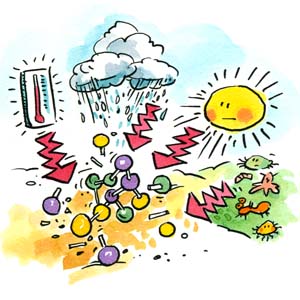What is Nickel?
Figure 1:Nickel Elemental Symbol
Nickel is a hard, corrosive and resistant metal. Nickel can be divided and used for many products:
- Nickel can be alloyed with steel to make amour plats, vaults and machine parts
- Nickel can be alloyed with other metals to improve the strength and resistance to corrosion
- Nickel can be used to manufacture coins and batteries
- Nickel (finely divided) can be used as a catalyst for the hydrogenation of vegetable oil
- Nickel can be added to glass to give it the green color
Figure 2: The element Nickel in pure form
Nickel is a good conductor of electricity and heat. It is one of the four elements that are ferromagnetic (which means magnetized easily) at room temperature. Nickel is considered a transition metal, which means that is has valance electrons in two shells instead of just one (this allows it to form several different oxidation states). Nickel functions as a cofactor for metalloenzymes and helps with the GI absorption of iron and zinc.
Nickel can be considered a trace mineral nutrient. Nickel helps plants liberate nitrogen from the soil an absorb iron. Although the number is unknown, the typical American diet supplies an estimated 0.3 to 0.6mg of nickel daily.
Brief History of Nickel
Now that we know what Nickel is, lets understand the history of Nickel. Nickel comes from a German word, meaning “Old Nick”. Nickel was discovered by the Swedish chemist Axel Fredrik Cronstedt in 1751. A interesting face about Nickel is how it was discovered. An American astrophysicist had a theory that an asteroid that struck the earth contained so much nickel, that it was responsible for the mass extinction of dinosaurs. Nickel spread into the vegetation of plants and water and poisoned the herbivore dinosaurs. The herbivore dinosaurs became extinct, which led to the extinction of carnivore dinosaurs. Most of the worlds supply of Nickel is found in Sudbury region of Ontario, Canada.
Figure 3: Nickel Plating Plant
Nickel is the fifth most abundant element on Earth and the second most abundant element in the Earth’s inner core. Nickel can be found in two types of deposits: laterite deposits (which is the result of intensive weathering of surface nickel-rich rocks) and magmatic sulfide deposits. The main mineral sources of nickel are limonite, garnierite, and pentlandite.
Exposure to Nickel
Nickel can enter the atmosphere and expose humans a variety of different ways including:
- Refining Plants
- Power Plants
- Trash incinerators
- (Once airborne) nickel can attach to the dust in the air, causing it to fall to the ground to mix with rain and snow. This eventually allows for Nickel to enter the soil.
- Cigarette smoking
- Skin to Skin contact through handling soil, water, or coils
- Eating nickel contaminated food
Figures 4-6: Exposure to Nickel (power plant, trash incinerator, and cigarette smoking)
Nickel Poisoning
Larger amounts of nickel can be considered a carcinogen, and it increases the risk of lung, nose, and throat cancer. Nickel poisoning can also cause respiratory problems (asthma and bronchitis) if the nickel is inhaled. There are two sets of symptoms associated with nickel poisoning, initial symptoms and secondary symptoms. The initial symptoms of nickel poisoning occur within 16 hours of infection and progress rapidly, they are listed as:
Figure 7: Nickel Toxicity
- headache

- nausea
- vomiting
- dizziness
- irritability
- difficulty sleeping
The secondary symptoms are the ones that occur after the 16 hour mark. These symptoms can be similar to pneumonia and can be fatal, there are listed as:
- chest pains
- sweating
- rapid heart beat
- dry cough
Treatment of Nickel Poisoning
There is a good outcome for the treatment of nickel poisoning, as a long as it is started immediately. There are several treatments for nickel poisoning. These treatments are on a case-by-case basis and they include:
Figure 8: Chelation Therapy
- Giving oxygen
- Chelation therapy – chelating agents will be used to rid the heavy metal from the body
- Antibiotics
- Corticosteroids
- Bed Rest
Nickel Deficiency
Now that we have discussed nickel poisoning, we can move to nickel deficiency. Nickel deficiency in the body is rare due to the small needed quantity. The lack of nickel in the human body has not been sufficiently tested on humans. The lack of nickel has been studied in animals and the symptoms include slowed growth, reproductive changes, and altered fats/glucose levels in the body.
Text References
- https://education.jlab.org/itselemental/ele028.html. Retrieved 5/23/19.
- https://www.livescience.com/29327-nickel.html. Retrieved 5/23/19.
- https://safety.lovetoknow.com/Remedies_for_Food_Poisoning. Retrieved 5/24/19.
- https://www.mineravita.com/eng/nickel_disorders.php. Retrieved 5/24/19.
- https://www.dcnutrition.com/minerals/nickel-ni/. Retrieved 5/24/19.
Figure References:
- https://www.vectorstock.com/royalty-free-vectors/chemical-element-nickel-vectors. Accessed 6/2/19.
- https://en.wikipedia.org/wiki/Nickel. Accessed 6/2/19.
- https://blog.priorsrec.co.uk/nickel-and-chrome-plating-a-brief-history/. Accessed 6/2/19.
- http://www.civmats.com/news/news37/news37.HTML. Accessed 6/2/19.
- https://www.tampabay.com/news/localgovernment/pasco-extends-contract-with-operator-of-trash-incinerator/2157486. Accessed 6/3/19.
- https://www.modernmom.com/2c620212-051f-11e2-9d62-404062497d7e.html. Accessed 6/2/19.
- https://myersdetox.com/nickel-toxicity/. Accessed 6/2/19.
- https://www.hormonesmatter.com/chelation-therapy-medicine/. Accessed 6/2/19






